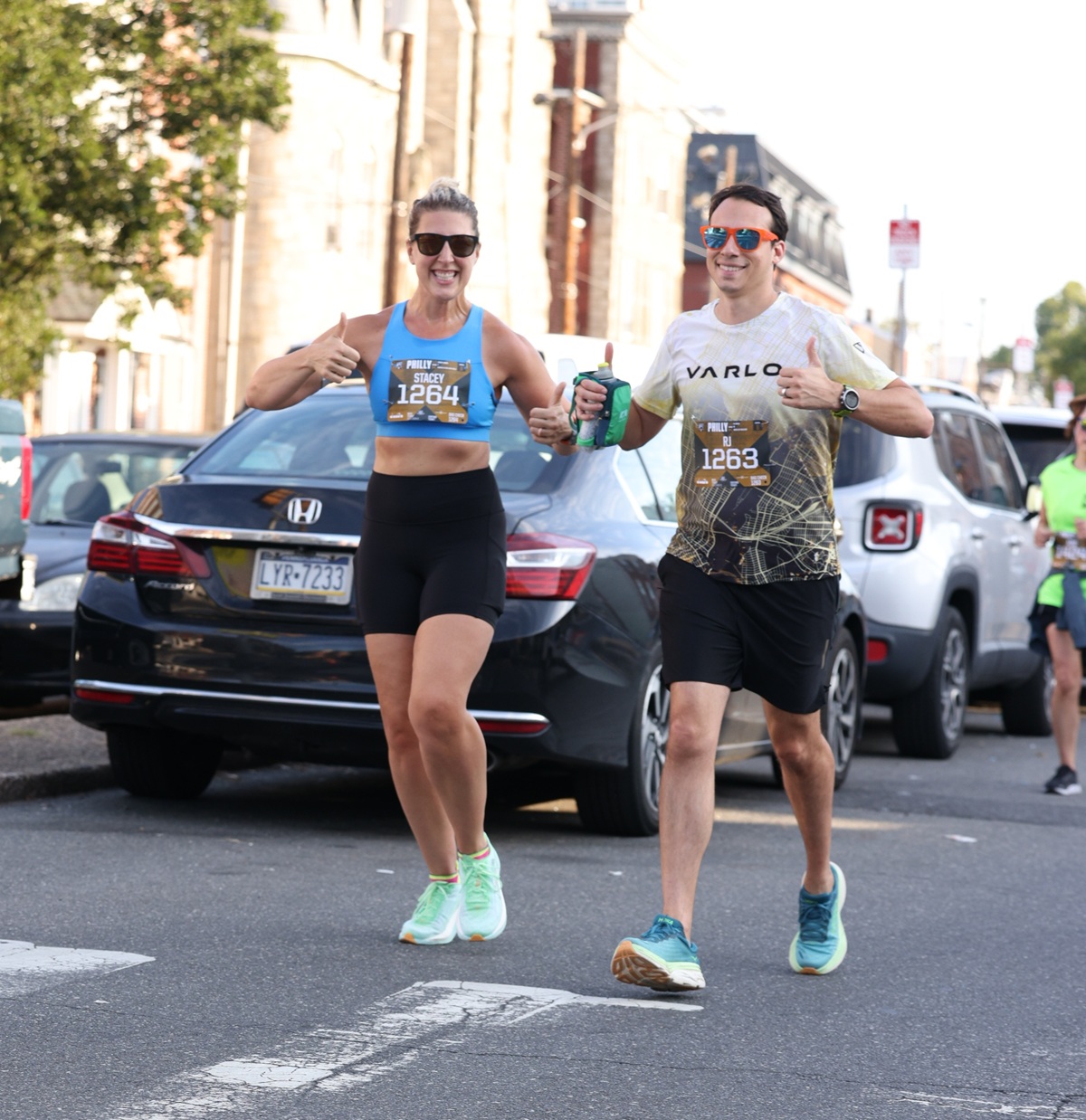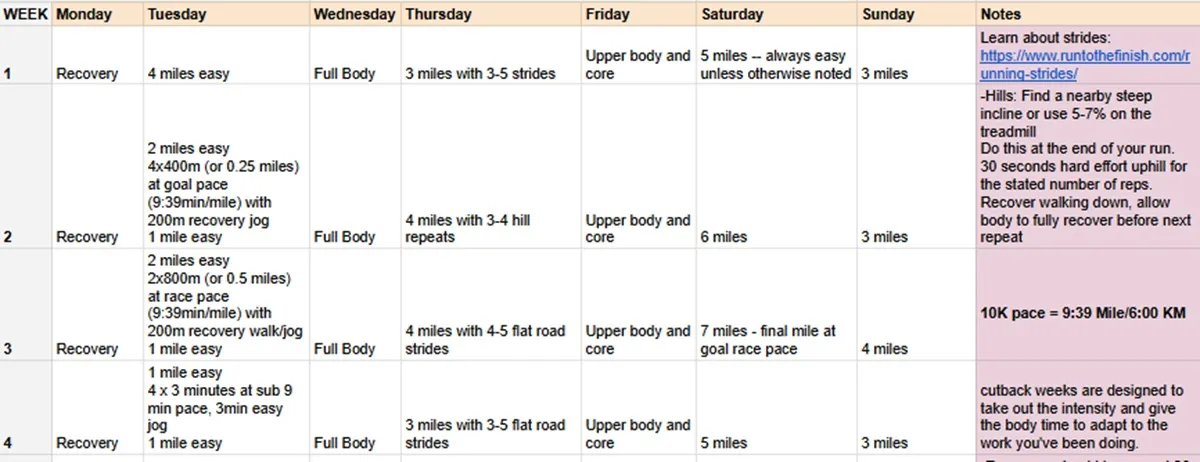If you’re looking for how to run a 10k in a hour, you’ve found yourself in the right place. As long time running coaches we’ve put together thousands of custom plans. Which means we do our best to create free options as well that you can utilize when coaching isn’t an option.

Training for a 10k is about finding that sweet spot. You’re not pushing for an all out effort like the 5k, and you’re not spending a long time on your feet like with the half marathon.
There’s that perfect blend of speed, endurance, and even learning how to fight the mental hurdles that will pop up along the way.
It’s a fun distance that is going to help make you an overall stronger runner, no matter what your goals are for the future.
Honestly, it’s one of my favorite distances to train for and race. Those 6.2 miles give you so many ways to challenge yourself, and hitting that hour mark is a super popular (and totally doable!) goal.
So, let’s dive into the fun stuff of the training plan and what you can expect.
Who is this 60 Min 10k Training Plan For?
This 10-week training plan will be perfect if you have a solid base of running or run/walking before starting.
You should be able to cover at least 5 miles for your longest run, have some experience with speed workouts, and run around 15-20 miles per week.
A 60 minute 10k requires a goal pace averaging 9:39 mile/5:59 km, so while you have 10 weeks to prepare, it’s important to set a goal that feels challenging but realistic for where you’re starting.
And a reminder that 9:39mi/5:59 km is if you hit exactly 6.2, so we often want to train at closer to 9:29mi/5:59 km to give ourselves a little padding.
We’ve broken down what you can expect from the training plan below!
If you’re a beginner or need a little more practice at the distance, check out our other 10k training plans:

Sub-60 Minute 10k Training Plan Breakdown
In this 10 week plan, you’ll see a variety of workouts to help build your endurance and prepare you to run a 10k in a hour.
You’ll practice everything from your goal 10k pace, some workouts will be a little faster, and there will also be a few fast finish long runs. The goal of all of the workouts is to help you feel more comfortable with what it feels like to run your goal pace AND to have some energy left for that final push to the finish line.
No, we’re not expecting you to run 6.2 miles at race pace right out of the gate; that’s what training is for! Each week, you’ll get a little more familiar with your goal pace and a little more confident in holding it.
If you’ve run a 5k in 30 minutes, this is going to be a good next goal!
When starting this plan, you should be able to comfortably run 5 miles for a long run and a total of 15-20 miles per week.
If your race is going to have any elevation changes, make sure that you’re adding similar routes to your training so that you get comfortable tackling the uphills and downhills, especially at race day effort.
👉Get our free downloadable 60 minute 10k training plan and start using to train for your race!
For every single workout, it is expected that you’ll spend at least 5 minutes doing a dynamic warm up, we promise your body will thank you later!
Weeks 1-4 (Base Building)
Base building is the foundation of every training plan. During this phase, the goal is to steadily increase your weekly mileage so you can build a strong endurance base before adding tougher workouts.

Additionally, you’ll see some speed workouts incorporating your goal pace in addition to smaller workouts like hill sprints and strides. These will help you practice a little bit of leg turn over to see what running fast feels like and hill workouts build extra leg strength! We know they are tough, but so worth it.
Weeks 5-8 (Speed Development + Peak Week)
These workouts are designed to push you outside your comfort zone and prepare you both physically and mentally for race day. They’ll help you build speed, strength, and confidence so you can handle whatever the course throws your way.
It’s normal to feel a little intimidated, especially when you’re potentially running paces you haven’t yet. Just remember, the discomfort is temporary, and it’s there to make you stronger.
Make sure to prioritize recovery alongside these tougher workouts. Rest days, hydration, and proper nutrition are key to staying healthy and getting to the starting line ready to crush your race.
Weeks 9-10 (Tapering and Race Week)
Tapering is all about finding that sweet spot in training where your overall mileage decreases but you keep just enough intensity to stay sharp. If you cut back too much, there’s a chance that your legs will start to feel sluggish or heavy.
- Speed workouts during the taper aren’t going to be full-out efforts, but focusing on your goal pace so you get a few more chances to practice.
- Volume will gradually be reduced so that your body can recover and be ready to give it your all on race day!
If you’re looking for something that is more custom to your individual goals, don’t forget you can always reach out to us for 1:1 coaching!!

Training Tips for Every Runner
It doesn’t matter how many years of experience you have as a runner, there’s always something new to learn or be reminded about. Here are some tips to help you stay motivated and focused as you work toward your goal!
Shifting Your Mindset
Let’s get one thing straight….. it’s not “just” a 10K. So go ahead and stop saying that when someone asks what you’re training for. This distance deserves just as much respect as any other, and so does your training.
One thing that I try to talk about with the runners whom I coach is the mental side of running. The way you think and even talk about your runs can have a huge impact not just on how your workouts go but how you show up on race day, too.
Start building that mental strength now, no matter where you are in your training cycle. Even during the off-season, practicing how you talk to yourself matters. Quieting that negative mind chatter is a skill, and it’ll make you a stronger runner all around.
Do Speed Work on the Roads, Not the Track
Look ahead at the race website and become familiar with what you can expect from the race course.
Along with training for the specific endurance and speed demands of the 10K, you should train for the specific terrain and surface upon which you will race.
Doing your speed work, especially repeats at 10K goal pace, on the roads will mimic the impact and changing terrain of race day. A track isn’t going to change; it’s going to be flat from start to finish. So, if you do all of your speed work on the track, you will struggle on any hills on race day.
Plus, running in flat circles always in the same direction can increase your risk of injury!
Don’t Skip Strength Training
Strength training is an important part of any training plan- no matter the distance. Strength training will reduce the risk of injury, improve your overall performance, and help you maintain better running form.
Do not make it super complicated and think that you need to spend hours at the gym.
Keep it simple with 20-30 minutes sessions focusing on full body workouts with bodyweight, resistance bands/weights or a combination will do just fine. (Of course, we also won’t complain if you can squeeze in more without overdoing it.)

Again, like with speed workouts, you will want to keep your lower body workout a few days apart from your long run so that you’re not running on super fatigued legs.
When you reach the taper, the focus will shift to core exercises and mobility to help you prepare for race day.
Fueling for a 10k
While your race isn’t going to be longer than an hour, some of your long runs will be, and that means fueling matters. It will help you recover better from the workout AND give you the energy to finish. If you need some ideas, here’s a list of some of the best gels.
This is also the perfect time to dial in your pre-race routine. You don’t want to toe the startling line with an empty stomach. Use your training to test what sits well in your stomach and gives you the energy you need so there are no surprises on race day.
The goal will be to eat breakfast about 1-2 hours pre-race (or pre-long run), depending on how your stomach handles food. Some examples are:
- a banana, wrapped in a tortilla with 1 tbsp nut butter (great for grab and go)
- 2 slices of toast with peanut butter
- 1/2 cup oatmeal with berries
- Drink some electrolytes!
Rest Days Are a Must
10 weeks may feel like such a short time, but scheduled cutback weeks are still important. Without that recovery, you are just piling on the stress and not providing time for your muscles, joints, and tendons to actually absorb the work and get stronger.
There is also 1 planned rest day each week; you can move it around but do not skip it.
As you go through training, listen to your body, and if you’re feeling more tired than usual, take an extra rest day. It’s not worth it to push through just to check something off of your list.
Start to look forward to your rest days and not dread them. Remember that you can’t give it your all in a workout or even on race day if you’re constantly pushing on empty.
Ready to get started?
👉Get our free downloadable 60 minute 10k training plan and start using to train for your race!
There is so much more we could tell you, that’s why there are 2,000 articles around here! But if you have a question, drop it below and we can help point you to more info!!!
Hopefully, this training plan will help you to feel excited to go after that goal to run a 10k in a hour.



 Skechers Max Cushioning Arch Fit Review | Unique Support For A Sturdy, Comfortable Ride
Skechers Max Cushioning Arch Fit Review | Unique Support For A Sturdy, Comfortable Ride
